Governing for Spatial Reconfiguration in Tourism-Oriented Peri-Urban Villages: New Developments from Three Cases in China
Abstract
:1. Introduction
2. Literature Review
3. Materials and Methods
3.1. Case Study Areas
3.2. Data Collection and Analysis
3.2.1. Interviews and Field Investigation
3.2.2. Questionnaire Surveys
4. Findings
4.1. Description of New Collaborative Governance Approaches
4.1.1. Collaborative Governance Led by the Town Government
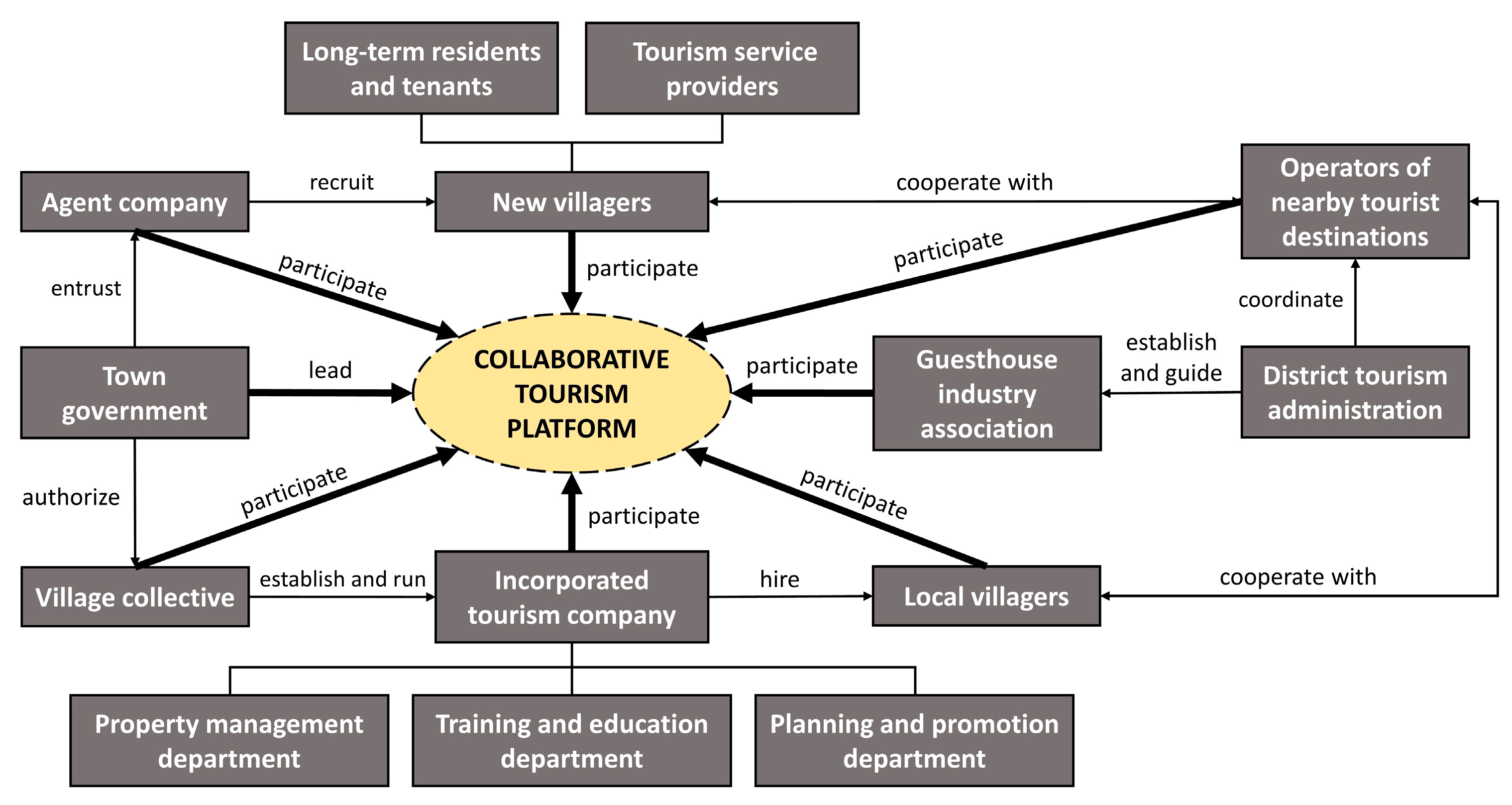
4.1.2. Collaborative Governance Led by a State-Owned Enterprise
4.1.3. Collaborative Governance Initiated by the Artist Group
4.2. Evaluation of New Collaborative Governance Approaches
4.2.1. Motivations of Initiators
The Peninsula is designated as the tourism and leisure area in the comprehensive plan of Shenzhen City due to its coastal scenery. There are more than 40 peri-urban villages in this area that have the potential to develop tourism. The local government chose Jiaochangwei to demonstrate the feasibility and build the confidence of other villages. However, due to the limited resources that may be offered by the government, other villages need to depend more on themselves to attract investment. We use Jiaochangwei as a testing ground and hope that its renewal lessons can contribute to the joint development of tourist villages in the surrounding area.
The vast rural area has become the new focus of national development since the launch of the Rural Revitalization Strategy in 2017. As a central government-affiliated enterprise, we need to inform the general public of our commitment to revitalizing rural communities. We aim to demonstrate our capability and expertise in this project, so we set certain criteria when selecting target villages to reach a cost-benefit balance.
When I was running an artists’ studio in Zhongshan City, I met a city official. In 2008 he asked me if it was possible to start an artists’ community as part of the local effort to build a renowned historical and cultural city. He suggested several locations and I chose Shimen Village for its proximity to Dr. Sun Yat-sen’s birthplace. In my opinion, it should be able to attract artists.
4.2.2. Satisfaction Levels and Potential Conflicts
4.2.3. Impact on Physical Environment and Socioeconomic Conditions
The tourism service association offers us a variety of professional training and social education opportunities. In these courses, we can learn a lot of practical knowledge about how we operate and manage our business, how we work together with other stakeholders, and the importance of protecting the environment.
Shimen Village gives us a lot of artistic inspiration. For one thing, the villagers treat us like family members. Their daily life becomes valuable material for our creation. They often share their opinions on what to paint when we paint outdoors and invited us to their houses for dinner at mealtime. For another, the small number of tourists ensures that our artistic creations are not overly disturbed. In addition, we are under no pressure to pay high rent. In return, we only have to submit two original paintings each year.
5. Discussion
5.1. Theoretical and Practical Contributions
5.2. Limitations and Future Research
6. Conclusions
Author Contributions
Funding
Institutional Review Board Statement
Informed Consent Statement
Data Availability Statement
Conflicts of Interest
References
- Sun, Y.; Shao, Y.; Chan, E.H.W. Co-Visitation Network in Tourism-Driven Peri-Urban Area Based on Social Media Analytics: A Case Study in Shenzhen, China. Landsc. Urban Plan. 2020, 204, 103934. [Google Scholar] [CrossRef]
- Dadashpoor, H.; Ahani, S. Explaining Objective Forces, Driving Forces, and Causal Mechanisms Affecting the Formation and Expansion of the Peri-Urban Areas: A Critical Realism Approach. Land Use Policy 2021, 102, 105232. [Google Scholar] [CrossRef]
- Lang, W.; Chen, T.; Li, X. A New Style of Urbanization in China: Transformation of Urban Rural Communities. Habitat Int. 2016, 55, 1–9. [Google Scholar] [CrossRef]
- Zhao, L.; Shen, Y.; Gu, N.; Dai, J. Development Mode of Recreation Belt around the City: Ecological Authenticity or Fashion Creativity? Bioinorg. Chem. Appl. 2022, 2022, 9292668. [Google Scholar] [CrossRef]
- Tan, T.; Zha, J.; Tang, J.; Ma, R.; Li, W. Spatial-Temporal Disparities in the Impact of the Coronavirus Disease 2019 on Domestic Tourism Demand: A Study of Emeishan National Park in Mainland China. J. Vacat. Mark. 2022, 28, 261–284. [Google Scholar] [CrossRef]
- Hu, Y.; Ngai, P. Organizational Communications in Developing Ethnic Tourism: Participatory Approaches in Southwest China. Tour. Cult. Commun. 2021, 21, 123–142. [Google Scholar] [CrossRef]
- Wang, Z.; Dong, F. Experience of Pro-Poor Tourism (PPT) in China: A Sustainable Livelihood Perspective. Sustainability 2022, 14, 4399. [Google Scholar] [CrossRef]
- Li, J. Culture and Tourism-Led Peri-Urban Transformation in China—The Case of Shanghai. Cities 2020, 99, 102628. [Google Scholar] [CrossRef]
- Dahliyana, K.A.; Hadian, V.A. Citizenship Education in Community Development in Indonesia: Reflection of a Community Development Batik Tourism Village. In Promoting Creative Tourism: Current Issues in Tourism Research; Routledge: London, UK, 2021; pp. 35–40. ISBN 1-00-309548-8. [Google Scholar]
- Wong, S.W.; Dai, Y.; Tang, B.; Liu, J. A New Model of Village Urbanization? Coordinative Governance of State-Village Relations in Guangzhou City, China. Land Use Policy 2021, 109, 105500. [Google Scholar] [CrossRef]
- Dai, S.; Xu, H.; Chen, F.; Wei, C. Navigating Adaptive Cycles to Understand Destination Complex Evolutionary Process. Curr. Issues Tour. 2022, 1–16. [Google Scholar] [CrossRef]
- Yang, J.; Qin, M.; Feng, W.; Zhou, J.; Zhu, D.; Fang, Y. The Characteristics and Mechanism of Place Reconstruction in Rural Revitalization with the Participation of Government, State-Owned Enterprises and Rural Community: Taking Huanglongxi Village for Example. J. South China Norm. Univ. 2022, 54, 60–69. [Google Scholar]
- Peng, H.; He, R.; Weng, S. Collaborative Governance Model of Tourism Urbanization in Rural Areas: A Case Study of Shuiji Village in Taining County, Fujian. Geogr. Res. 2018, 37, 2383–2398. [Google Scholar]
- Bichler, B.F.; Lösch, M. Collaborative Governance in Tourism: Empirical Insights into a Community-Oriented Destination. Sustainability 2019, 11, 6673. [Google Scholar] [CrossRef]
- Lu, S.; Rao, X.; Duan, P. The Rural Gentrification and Its Impacts in Traditional Villages―A Case Study of Xixinan Village, in China. Sustainability 2022, 14, 77. [Google Scholar] [CrossRef]
- Li, W.; Zhou, Y.; Zhang, Z. Strategies of Landscape Planning in Peri-Urban Rural Tourism: A Comparison between Two Villages in China. Land 2021, 10, 277. [Google Scholar] [CrossRef]
- Beritelli, P.; Bieger, T.; Laesser, C. Destination Governance: Using Corporate Governance Theories as a Foundation for Effective Destination Management. J. Travel Res. 2007, 46, 96–107. [Google Scholar] [CrossRef]
- Ruhanen, L.; Scott, N.; Ritchie, B.; Tkaczynski, A. Governance: A Review and Synthesis of the Literature. Tour. Rev. 2010, 65, 4–16. [Google Scholar] [CrossRef]
- Emerson, K.; Nabatchi, T.; Balogh, S. An Integrative Framework for Collaborative Governance. J. Public Adm. Res. Theory 2012, 22, 1–29. [Google Scholar] [CrossRef]
- Murdoch, J.; Abram, S. Defining the Limits of Community Governance. J. Rural Stud. 1998, 14, 41–50. [Google Scholar] [CrossRef]
- Plumptre, T.W.; Graham, J. Governance and Good Governance: International and Aboriginal Perspectives. 1999, pp. 1–27. Available online: https://www.files.ethz.ch/isn/122184/govgoodgov.pdf (accessed on 18 January 2023).
- Hall, C.M. A Typology of Governance and Its Implications for Tourism Policy Analysis. In Tourism Governance; Routledge: London, UK, 2013; pp. 37–58. ISBN 0-203-72102-0. [Google Scholar]
- Bramwell, B. Governance, the State and Sustainable Tourism: A Political Economy Approach. J. Sustain. Tour. 2011, 19, 459–477. [Google Scholar] [CrossRef]
- Keyim, P. Tourism Collaborative Governance and Rural Community Development in Finland: The Case of Vuonislahti. J. Travel Res. 2018, 57, 483–494. [Google Scholar] [CrossRef]
- Gao, S.; Huang, S.; Huang, Y. Rural Tourism Development in China. Int. J. Tour. Res. 2009, 11, 439–450. [Google Scholar] [CrossRef]
- Kline, C.; Duffy, L.; Clark, D. Fostering Tourism and Entrepreneurship in Fringe Communities: Unpacking Stakeholder Perceptions towards Entrepreneurial Climate. Tour. Hosp. Res. 2020, 20, 3–17. [Google Scholar] [CrossRef]
- Shih, M. Rethinking Displacement in Peri-Urban Transformation in China. Environ. Plan. Econ. Space 2017, 49, 389–406. [Google Scholar] [CrossRef]
- Keyim, P. Tourism and Rural Development in Western China: A Case from Turpan. Community Dev. J. 2016, 51, 534–551. [Google Scholar] [CrossRef]
- Shen, M. From Rural Construction to Rural Operation: Benefit and Dilemma of the Market-Oriented Service Provision in China’s Rural Revitalization. City Plan. Rev. 2020, 44, 9–17. [Google Scholar]
- Su, Y.; Li, R.; Ma, H.; Huang, L. Adaptive Change of Institutions and Dynamic Governance of the Tragedy of the Tourism Commons: Evidence from Rural China. J. Hosp. Tour. Manag. 2022, 53, 32–49. [Google Scholar] [CrossRef]
- Seamon, D.; Sowers, J. Place and Placelessness, Edward Relph. In Key Texts in Human Geography; SAGE Publications Ltd.: London, UK, 2008; pp. 43–51. [Google Scholar]
- Tolstad, H.K. Development of Rural-Tourism Experiences through Networking: An Example from Gudbrandsdalen, Norway. Nor. Geogr. Tidsskr.-Nor. J. Geogr. 2014, 68, 111–120. [Google Scholar] [CrossRef]
- Bao, J.; Meng, K.; Zhang, Q. Rural Urbanization Led by Tourism. Geogr. Res. 2015, 34, 1422–1434. [Google Scholar]
- Zhu, J.; Guo, Y. Fragmented Peri-Urbanisation Led by Autonomous Village Development under Informal Institution in High-Density Regions: The Case of Nanhai, China. Urban Stud. 2014, 51, 1120–1145. [Google Scholar] [CrossRef]
- Liu, R.; Wong, T.-C.; Liu, S. The Peri-Urban Mosaic of Changping in Metropolizing Beijing: Peasants’ Response and Negotiation Processes. Cities 2020, 107, 102932. [Google Scholar] [CrossRef]
- Yang, J.; Zhang, J. Rethinking Capital in Rural Governance from A Corporatism Perspective: Empirical Research in Village H, Jiangxi Province. Urban Plan. Int. 2020, 35, 98–105. [Google Scholar]
- Ansell, C.; Gash, A. Collaborative Governance in Theory and Practice. J. Public Adm. Res. Theory 2008, 18, 543–571. [Google Scholar] [CrossRef]
- Lu, L.; Chen, H.; Fu, L. Process and Mechanism of Function Evolution of Traditional Villages Under the Background of Tourism Development: A Case Study of Xixinan Village, Huangshan City. Sci. Geogr. Sin. 2022, 42, 874–884. [Google Scholar]
- Wei, X.; Hu, Q. Development of Rural Tourism in China: The Tragedy of Anti-Commons. Front. Public Health 2022, 10, 939754. [Google Scholar] [CrossRef]
- Lin, D.; Simmons, D. Structured Inter-Network Collaboration: Public Participation in Tourism Planning in Southern China. Tour. Manag. 2017, 63, 315–328. [Google Scholar] [CrossRef]
- The OCT Group. The Overseas Chinese Town Group’s Beautiful Country Practices; China Tourism Press: Beijing, China, 2021; ISBN 978-7-5032-6640-9. [Google Scholar]
- Zhu, J.; Ni, D. Jiaochangwei Guesthouse Village Implements Enclosed Management from Today. Available online: https://sz.house.ifeng.com/news/2019_06_13-52113695_0.shtml (accessed on 15 January 2023).
- Zhang, Y.; Ni, D. Jiaochangwei Ranks First among Gueshouse Villages in the Country, Reported by CCTV. Available online: http://www.sz-qb.com/attachment/pdf/202005/09/d112025c-4a09-42bd-87d3-cc6aef6e9748.pdf (accessed on 15 January 2023).
- Dayi Media Center. The Linpan Landscape in Dayi Redefines the Countryside of Chengdu’s Park City Goal. Available online: http://nynct.sc.gov.cn/nynct/c100632/2019/11/15/f2894ce8a3184766b9f571551c1b5e20.shtml (accessed on 20 January 2023).
- Yang, F. The Overseas Chinese Town Group Explores a New Path for High Quality Development of Cultural Tourism Industry. Available online: https://www.yicai.com/news/101483868.html (accessed on 31 January 2023).
- Nanlang Town Cultural Service and Promotion Center. The “Painter Village” in the Ancient Village Lights up the Village Culture. Available online: https://gdxk.southcn.com/zs/nlzk/xwbd/content/post_652314.html (accessed on 1 February 2023).
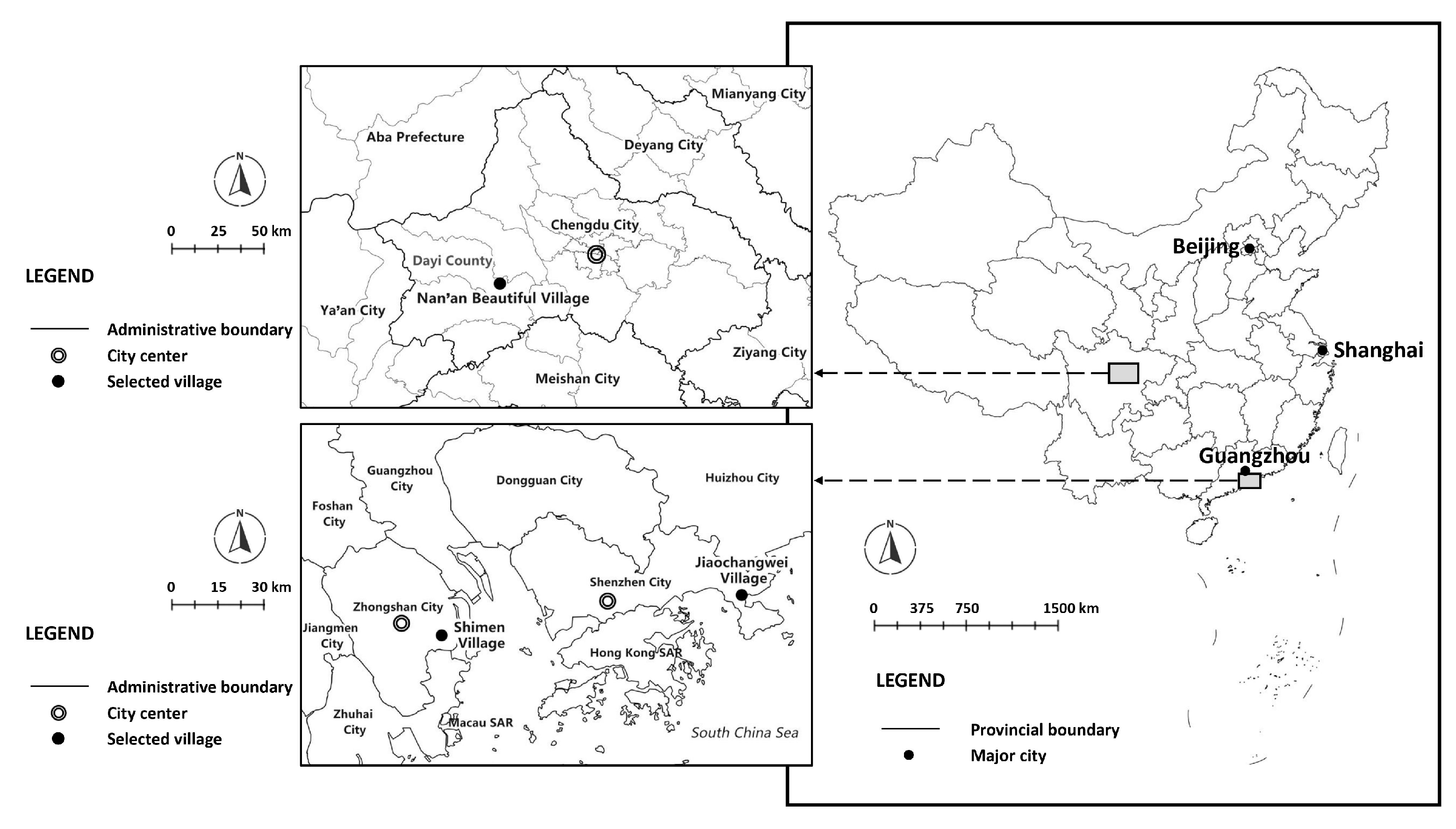

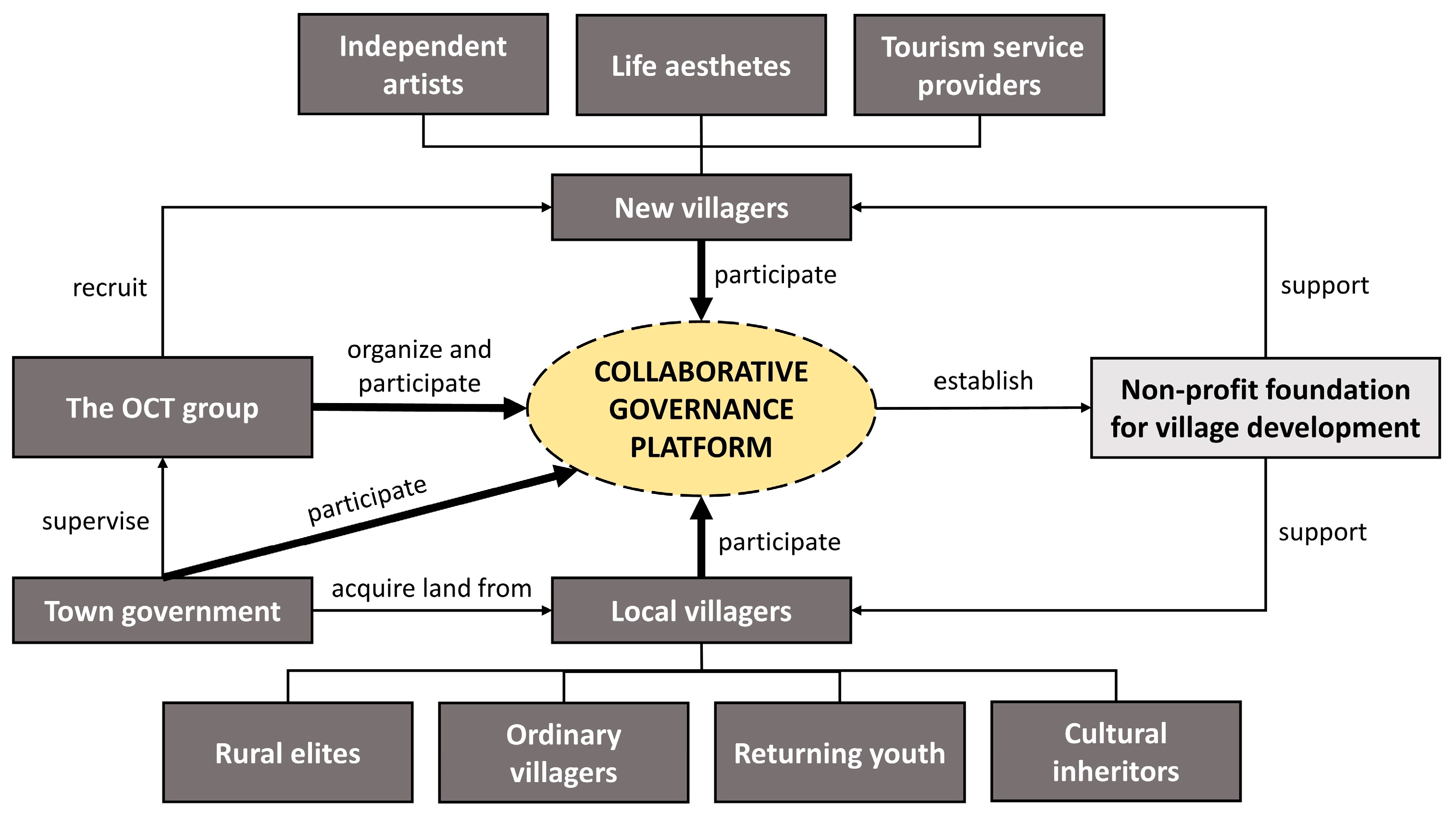

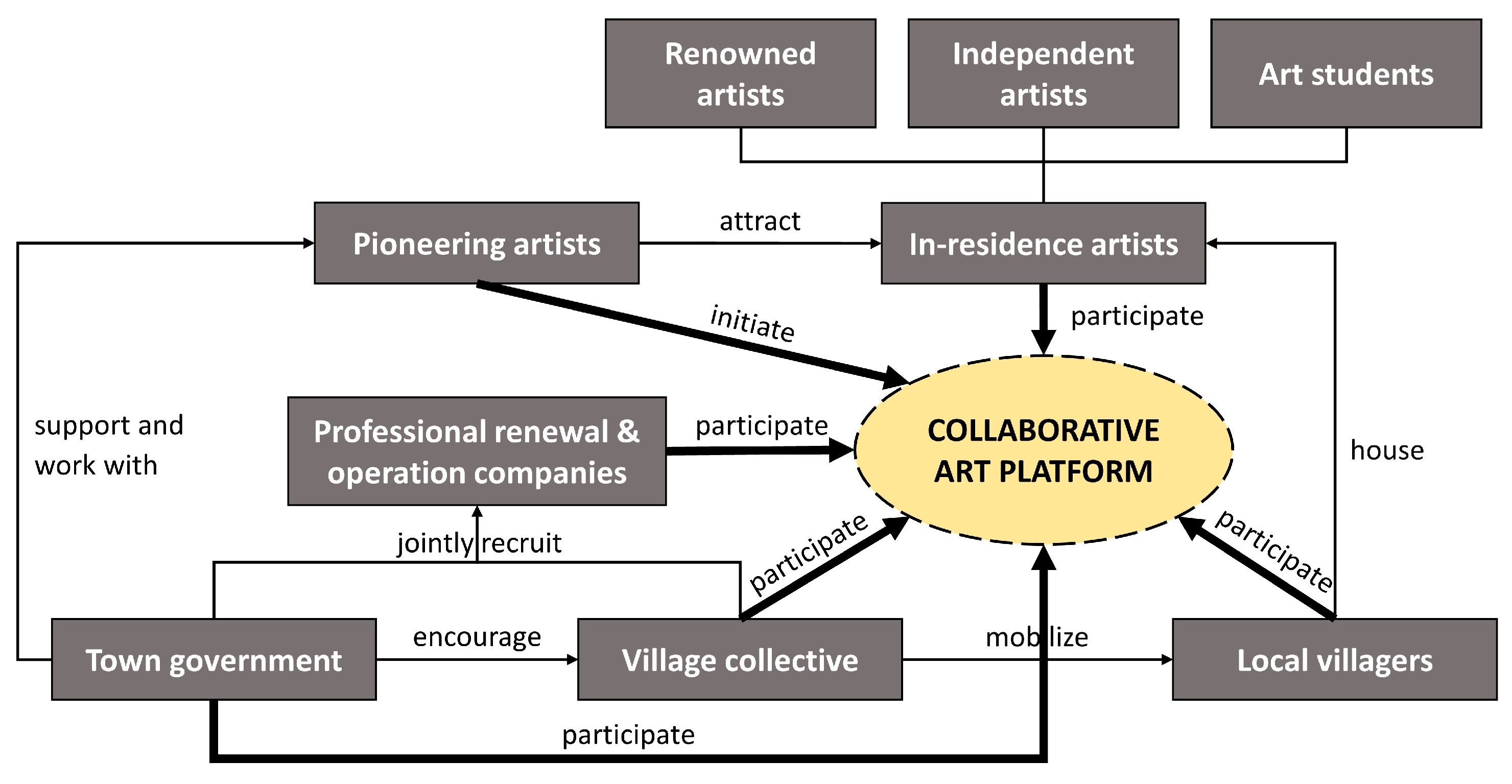
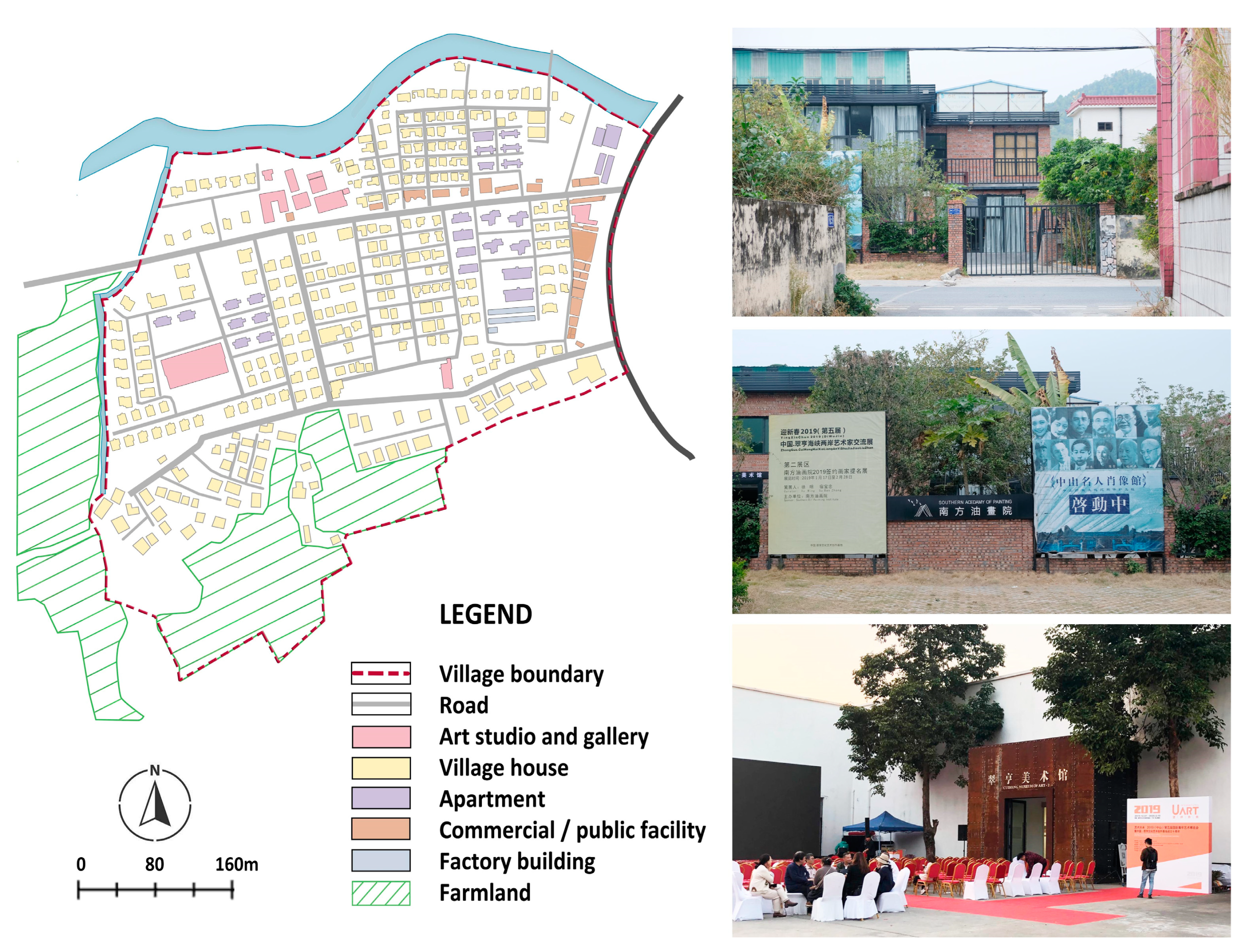
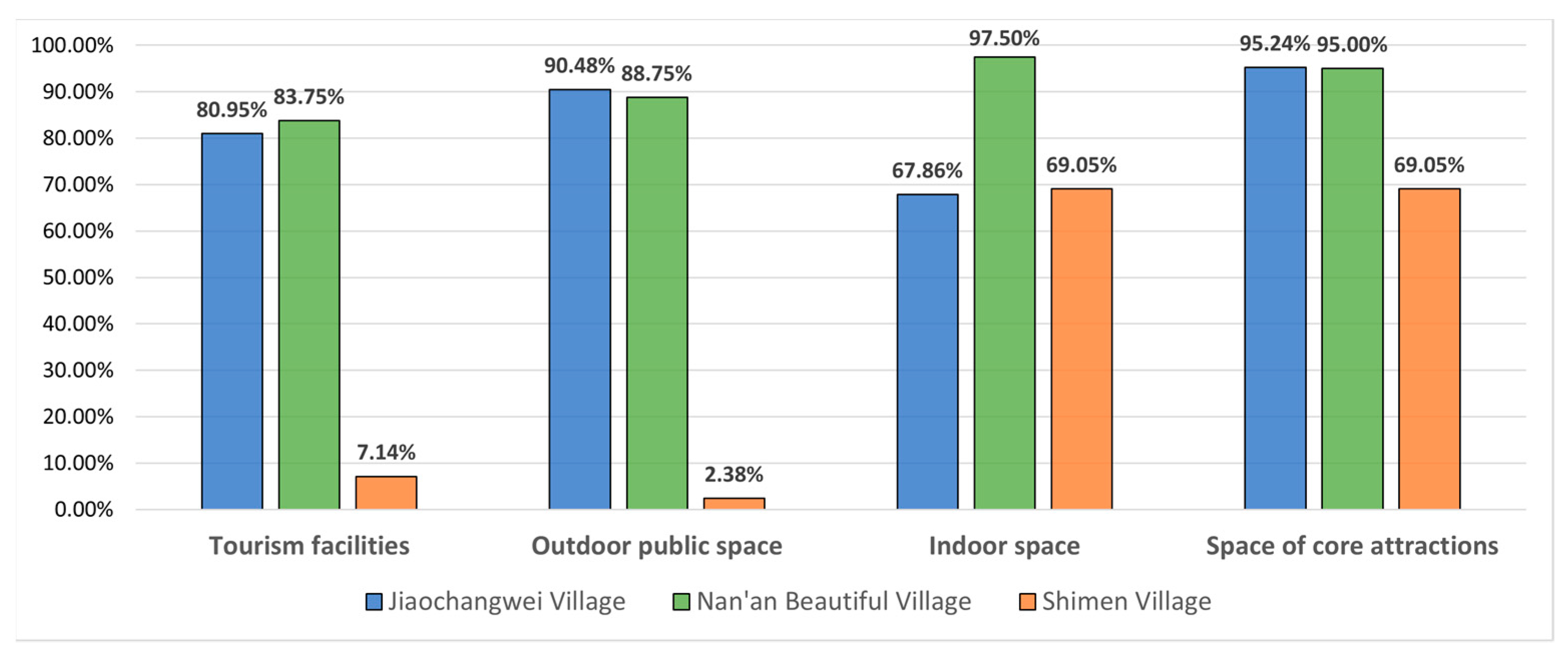
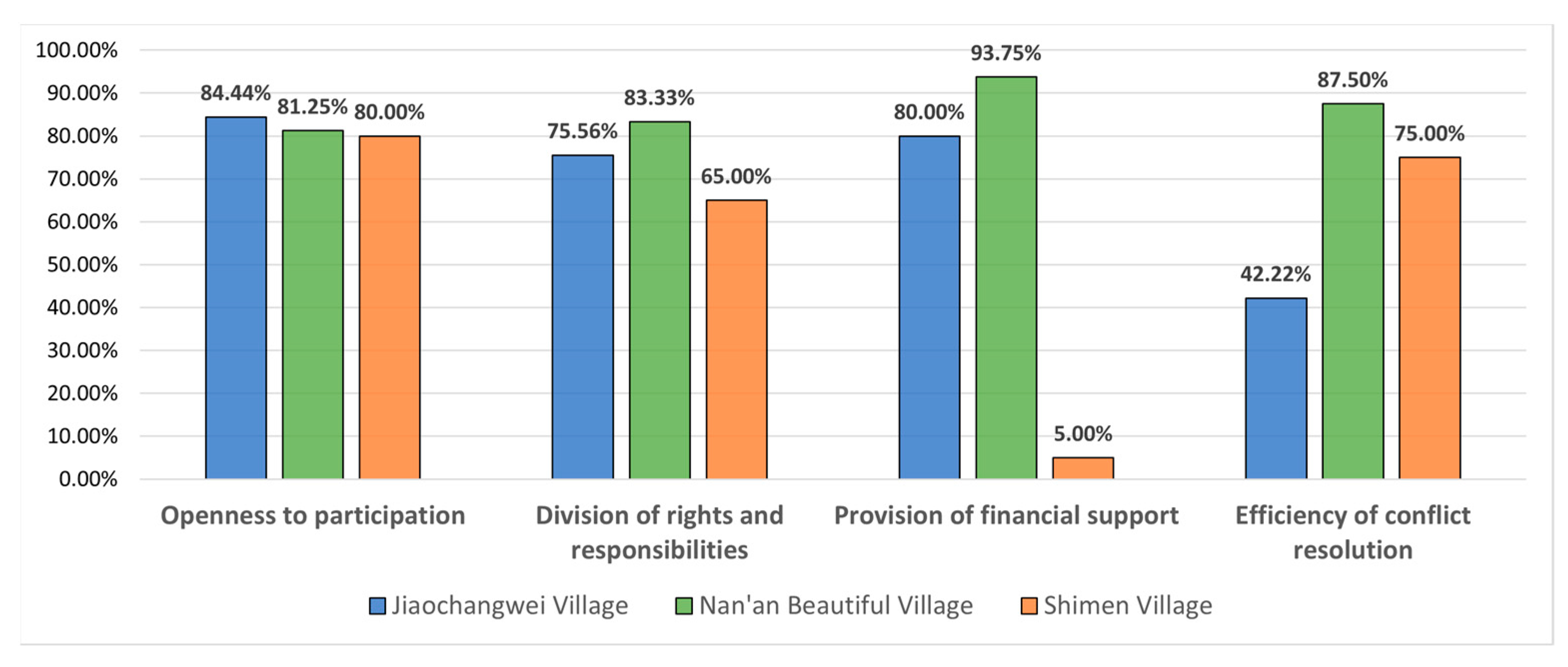
Disclaimer/Publisher’s Note: The statements, opinions and data contained in all publications are solely those of the individual author(s) and contributor(s) and not of MDPI and/or the editor(s). MDPI and/or the editor(s) disclaim responsibility for any injury to people or property resulting from any ideas, methods, instructions or products referred to in the content. |
© 2023 by the authors. Licensee MDPI, Basel, Switzerland. This article is an open access article distributed under the terms and conditions of the Creative Commons Attribution (CC BY) license (https://creativecommons.org/licenses/by/4.0/).
Share and Cite
Shao, Y.; Sun, Y. Governing for Spatial Reconfiguration in Tourism-Oriented Peri-Urban Villages: New Developments from Three Cases in China. Buildings 2023, 13, 519. https://doi.org/10.3390/buildings13020519
Shao Y, Sun Y. Governing for Spatial Reconfiguration in Tourism-Oriented Peri-Urban Villages: New Developments from Three Cases in China. Buildings. 2023; 13(2):519. https://doi.org/10.3390/buildings13020519
Chicago/Turabian StyleShao, Yiwen, and Yao Sun. 2023. "Governing for Spatial Reconfiguration in Tourism-Oriented Peri-Urban Villages: New Developments from Three Cases in China" Buildings 13, no. 2: 519. https://doi.org/10.3390/buildings13020519
APA StyleShao, Y., & Sun, Y. (2023). Governing for Spatial Reconfiguration in Tourism-Oriented Peri-Urban Villages: New Developments from Three Cases in China. Buildings, 13(2), 519. https://doi.org/10.3390/buildings13020519







